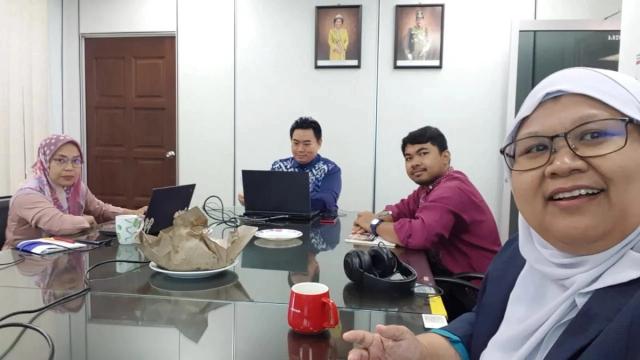Universiti Utara Malaysia Engages SDSN Malaysia Sub-State-Level SDG Dashboard as a University Community Outreach Tool
On 16 March 2023, Universiti Utara Malaysia (UUM) invited the SDSN Malaysia to brief staff on the use of Malaysia's first Sub-State-Level SDG Dashboard for its university-wide community outreach program. Since the launch of the SDGs for Malaysian States dashboard in 2022, the SDSN Malaysia Secretariat has embarked on further localizing the dashboard to sub-state level, with Kedah as its pilot. Kedah, a state in northern peninsular Malaysia, is home to UUM, one of Malaysia's largest public universities and member of SDSN Malaysia.
UUM Focal Points, Assoc Prof Masnita Misiran @ Bakun and Dr Saadi Ahmad Kamaruddin, played key roles in organizing the briefing. Prof Misiran and Dr. Kamaruddin are from the Centre for Testing, Measurement and Appraisal (CeTMA). CeTMA's role in UUM's sustainability transformation involves setting localized campus indicators, convening multidisciplinary taskforces of UUM academics to develop sustainability solutions initiatives, and mobilizing a whole-of-campus approach.
Mdm. Rohani Abdullah (Deputy Director of CeTMA), Dr Saadi Ahmad Kamaruddin (Deputy Director of CeTMA and UUM focal point), Mr Amirul Haziq bin Abd Kadir (MySTEP), Assoc Prof Masnita Misiran @ Bakun (Director of CeTMA and UUM focal point)
Twenty two coordinating administrators and academics from UUM's Community Outreach Programme or MEKAR programme (Membina Kesejahteraan Rakyat) attended the briefing. MEKAR is a university-to-community knowledge transfer programme. This initiative formalizes UUM's role in the state's community development as it strategically involves all three UUM Colleges, and by extension all of its sixteen schools. The briefing familiarized MEKAR coordinating officers with the Sub-State Malaysian SDG Dashboard, thereby paving the way to its use as a preliminary tool for intervention design.
Danesh Prakash Chacko from the Jeffrey Sachs Center on Sustainable Development conducted the briefing. Participants were familiarized with the methodology and were given a demonstration of the Kedah Sub-State website. Chacko focused on the SDG performance for the state of Kedah, showing participants an overview of Kedah's Major SDG Challenges. The dashboard is hosted on the ArcGIS ESRI platform, which provides visual representations of data in the form of interactive maps. This includes visualisations which compare pre-and-post COVID-19 assessment for selected SDGs.
Chacko raised the ability to identify Districts to target interventions, "for the action plan you can focus on Districts like Yan, Kuala Muda." The dashboard may spur participants thinking when development perceptions do not align with assessments seen. "Sungai Petani is an economic hub full of industries, why is there [high] absolute poverty?" reflected Chacko.
Dr. Kamaruddin served as moderator for the 2 hour-long briefing with Kong Phui Yi, SDSN Malaysia Network Manager, as support during Question and Answer.
Dr. Kamaruddin's vision for the session was to align the community projects with the SDG performance for Kedah. Dr. Kamaruddin introduced SDSN as an organisation and the function of the SDG Dashboard to the participants. "Experts who are doing sustainability efforts in Kedah can troubleshoot lots of problems in Kedah [using the dashboard]," reflected Dr. Kamaruddin.
Participants asked about the methodology to measure SDG achievement. Chacko gave an explanation of trend, score and rating, pointing participants to the Methodology section of the dashboard website for more information.
A participant, Dr Darwinda Pero from UUM's School of International Studies, asked about interventions for the State Assembly Kuala Nerang, located in the northern district of Kubang Pasu. Kong highlighted a plan of action for Kuala Nerang, "[Firstly] you can look at entrepreneurial support for women, skills, bringing their products to market and small business support. Secondly, environmental awareness, to tell them about the benefits of ecosystem services in order to inform the local community to remind their local government to keep the forest intact, and lastly, because of uneven income distribution, you can see if there are areas that are underserved, as a way for information to flow, because sometimes the welfare officers may not have the capacity to cover the district sufficiently." Interactive maps enable the user to assess appropriate starting-points to assess local SDG gaps.
The Kedah Sub-State Dashboard also makes more granular level assessments available. The State has 12 Districts, further broken down into 36 State Constituencies.
The session further served to link UUM's staff to SDSN resources. Kamaruddin ended the session by encouraging the participants to make use of accessible online material to learn more about sustainable development, specifically the SDG Academy's Library. Looking forward, the participants were informed of the opportunity to participate in an upcoming localisation project of primary and secondary school lesson plans into the Malay language, coordinated by both UUM Focal Points Masnita and Kamaruddin.
